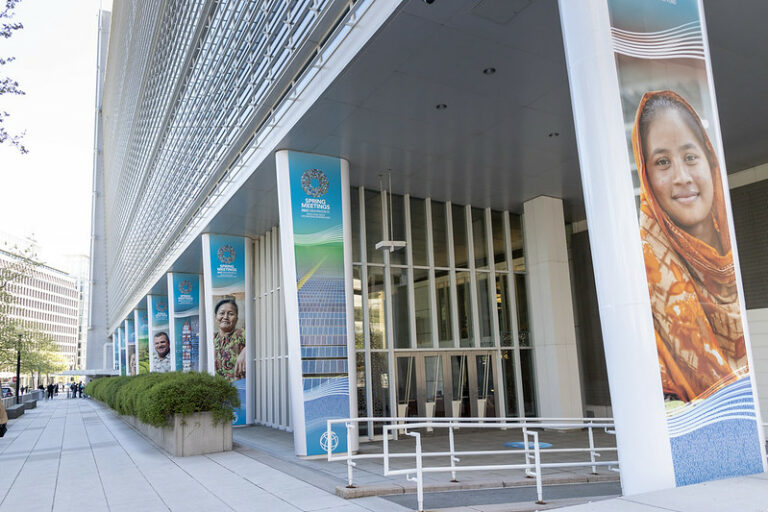Invisible precedent: where was the Clean Technology Fund at the World Bank Spring Meetings?

Earlier this month, world leaders convened in Washington, D.C. for the annual World Bank and International Monetary Fund (IMF) Spring Meetings. The Meetings followed the release of influential proposals for institutional reform, including the Bridgetown Initiative and the World Bank Group Evolution Roadmap – both of which prioritise climate change concerns alongside economic development. But notably absent from the conversations? The World Bank’s massive, longstanding vehicle for climate finance.
A strained week for climate policy
Much has been written about potential trade-offs between climate policy and poverty alleviation in the context of the World Bank’s emerging climate focus. These include accusations of over-extending limited resources; funnelling support to climate-vulnerable (or simply high-emitting) middle-income countries while not providing enough to low-income ones; and high-handed disregard for the domestic interests of developing countries. Fears remain that whereas developing countries badly need more grant money and concessional finance, too many words and frameworks are dedicated to stretching existing resources from the non-concessional pots – less-than-ideal offerings typically aimed at middle-income countries.
While a headline conclusion of the recent report from the Intergovernmental Panel on Climate Change states that “mitigation and adaptation actions have more synergies than trade-offs with Sustainable Development Goals,” the trillion-dollar question remains: can the World Bank’s ‘new’ climate agenda dovetail with the heterogeneous development needs and financial profiles of such diverse constituents as small island developing states, the least developed countries, emerging economies, and others?
The invisible precedent
In fact, the World Bank has maintained a ‘financial intermediary fund’ called the Climate Investment Funds (CIF) since 2008. The CIF was, until recently, the biggest climate fund in the world, and the CIF’s biggest, flagship program is the Clean Technology Fund (CTF). The CTF’s mission is to scale up financing to demonstrate, deploy and lead to the transfer of low-carbon technologies from developed countries, to avoid or reduce greenhouse gas emissions in the long term. This contributes to the climate-proofing of development pathways in low- and middle-income countries, addressing ‘frontier climate challenges the [multilateral development banks] can’t fight on their own’ through ‘transformational climate innovation’. Donors have contributed over $10 billion in funding to date – but few are talking about it.
A Google News search for ‘Clean Technology Fund’ for the week of the World Bank Spring Meetings yields nothing. One of the few scholarly results ever for the CTF, written by Dr Katherine Browne at the Stockholm Environment Institute, is at least able to suggest one reason why the “invisible precedent” of the CTF has been so well resourced: governance structure. Unlike the more egalitarian Green Climate Fund under the United Nations Framework Convention on Climate Change, wherein there is a balance of representation between developed and developing countries, under the CIF, contributor countries can earmark their contributions.
The security of the CTF – which allocates money exclusively through credit rating-conscious multilateral development banks – combined with the discretion of the donor, makes it an attractive destination for international climate finance from its nine contributor countries: Australia, Canada, France, Germany, Japan, Spain, Sweden, the UK, and the US. The UK, the second largest donor to the CTF overall, recently cited the CTF as an effective form of clean energy investment in its 2023 International Climate Finance Strategy, expressing dedication to continuing contributions through this channel.
Where the CTF fits in
The Spring Meetings dredged up major debates surrounding climate and development finance, but is the CTF equipped to respond to the challenge? This is unclear, though at least two avenues for engagement with these thorny questions remain.
First, the CTF is accessible to both middle- and low-income countries via multilateral development banks. This means that it can address the decarbonisation needs of high-emitting emerging economies and the development needs of low-income countries that require greater access to energy. Leveraging the existing institutional structure of the CTF (while ideally democratising its governance) is one, and potentially the least controversial, way to navigate the middle-income versus low-income country debate.
Second, the CTF appears to utilise the fairest of the popular climate finance instruments ‘on the market’ today: grants, contingent grants, concessional loans, equity, and guarantees to make investment more attractive to the public and private sectors. In this way, it resembles its more progressive cousin, the Green Climate Fund, and avoids the debt-burdensome pitfalls of non-concessional finance often associated with the World Bank and the IMF.
Conclusion
Ultimately, the primary advantage of the CTF as a lever for financing decarbonisation and spreading energy access in the Global South is that it already exists. While transformative restructuring of the World Bank could deliver more drastic change, it encounters significant political opposition and faces severe budget constraints. The Spring Meetings’ silence on refining and deploying the CTF is therefore not just unexpected, but disconcerting.
Alejandra Padín-Dujon is Climate Policy Advisor at the Catholic Agency for Overseas Development (CAFOD). The author would like to thank Eléonore Soubeyran for her review comments. The views in the commentary are those of the author and do not necessarily represent those of the Grantham Research Institute or CAFOD.

